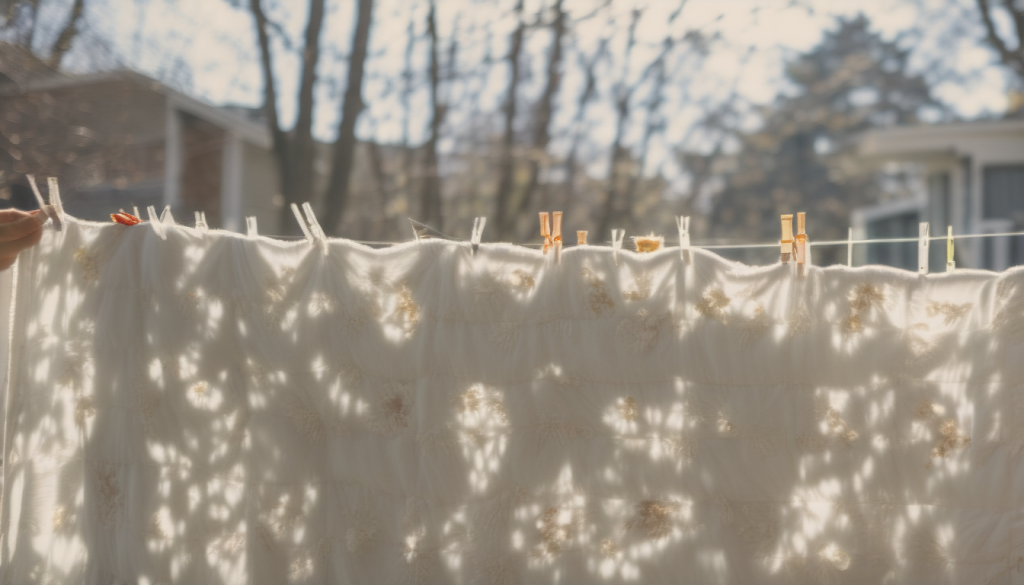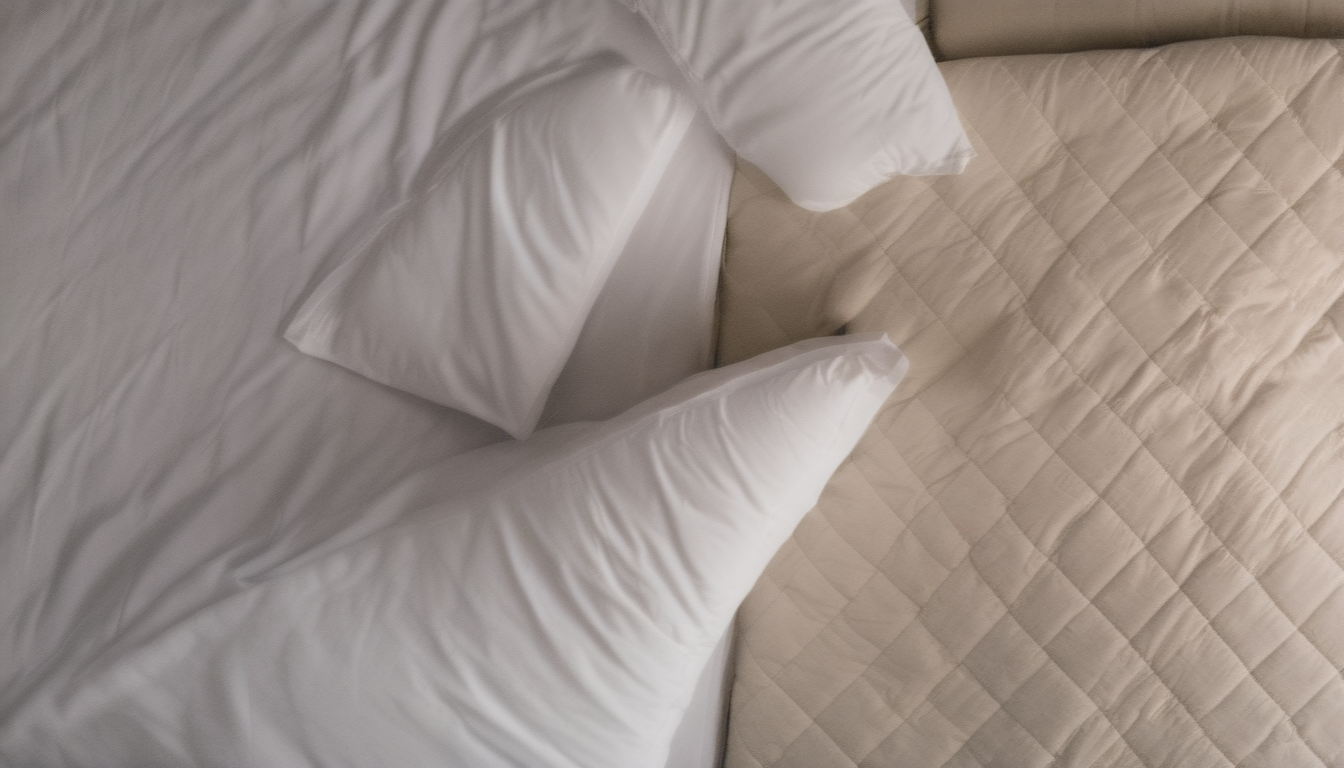Do you love snuggling under a warm, fluffy down comforter on a cold winter night? Many people adore the lightweight yet cozy warmth provided by traditional down bedding. But concerns about nighttime allergies, asthma triggers, and ethical sourcing have led some sleepers to explore alternatives.
This beginner’s guide has everything you need to know about down comforters, including:
- Benfits and drawbacks for your health
- Animal welfare and sustainability issues
- Hypoallergenic and ethical options
- Care and maintenance best practices
Follow our tips to choose the ideal ethically-produced, allergy-friendly comforter for a warm, soothing, healthy night’s sleep.
What Exactly Are Down Comforters?
Down comforters are quilted bed covers filled with insulating down feathers from ducks or geese. The fluffy fill creates air pockets that trap body heat, keeping sleepers cozy on cold nights.
Benefits of down comforters include:
- Lightweight warmth and breathability
- Soft, cushy feel many find comfortable
- Long-lasting with proper care (up to 10 years)
- Biodegradable and renewable natural material
However, down bedding does come with some drawbacks:
- Expensive – quality down is costly
- Requires more delicate care than synthetic comforters
- Raises animal welfare questions for some consumers
- Can trigger allergies and asthma in sensitive people
Next, let’s dive deeper into the health and ethical considerations around down bedding.
Down Comforters and Your Health
For most people, snuggling under a down-filled duvet poses no health issues. The concerns arise primarily for those with allergies, asthma, or sensitivities to dust, dander, and other particles.
Allergy and Asthma Triggers
The feathers themselves rarely trigger reactions. However, over time down can accumulate:
- Dust and dust mites – the microscopic insects’ feces are highly allergenic
- Mold, pollen, and other outdoor allergens
- Pet dander and human skin flakes
When someone sensitive inhales these particles from their bedding, it can provoke:
- Asthma attacks
- Stuffy nose, sneezing, watery eyes, and other allergy symptoms
- Difficulty breathing and sleep disruptions
This leads to an increase in inflammation and reduced sleep quality. Ongoing exposure may exacerbate lung diseases like chronic bronchiectasis.
Seeking Hypoallergenic Options
To benefit from a down comforter without health issues, the key is finding a hypoallergenic option. Features that help minimize allergens include:
- Tightly woven, breathable outer fabric
- Internal barrier fabrics to reduce particle infiltration
- Frequent washing and drying to kill dust mites
- Protective zippered covers
Later, we’ll explore your hypoallergenic down alternatives, from synthetic fills to wool, cotton, and silk comforters.
Ethical Concerns Around Down Production

Down is a byproduct of waterfowl raised for foie gras or meat. This means there are animal cruelty and environmental sustainability questions tied to commercial production.
Down Harvesting and Animal Welfare
Most down is collected during the slaughter process. But some unethical farms pluck the chest feathers from live geese – a painful practice.
- Force-feeding – Common for foie gras pâté production, involves inserting a tube down geese’s throats up to 4 times per day to swell the liver. Considered inhumane by animal welfare groups.
- Live-plucking – Pulling feathers from live birds instead of collecting during slaughter. Causes bleeding, open wounds, and suffering. Banned in the EU and UK but still occurs in some countries.
To ensure high standards of animal welfare, look for certifications like the Responsible Down Standard (RDS) when buying down bedding.
Sustainability Factors
As consumer awareness grows, more brands offer down from ethical, sustainable sources:
- Non-force-fed birds – Sourced from ducks and geese raised for meat or eggs without force-feeding
- Pasture-raised waterfowl allowed to graze freely outdoors on grass
- Locally farmed in areas with sustainable practices in place
- Traceability – Down can be tracked back to specific flocks to validate animal welfare
- Biodegradable and compostable materials for minimal environmental impact
- Recycled down salvaged from discarded bedding reduces waste
Synthetic vs Down: Comparing the Options
| Factor | Down Comforters | Synthetic Comforters |
|---|---|---|
| Material | Natural duck or goose down | Polyester fibers or Primaloft microfibers |
| Allergies? | Can provoke allergies and asthma | Generally hypoallergenic |
| Breathability | Excellent, keeps airflow moving | Varies, cheaper synthetics retain moisture |
| Durability | Lasts 8-10 years typically | 5 years max; clumping and flattening issues |
| Care | Dry clean; line dry only | Machine wash and dryer safe |
| Cost | $200+ for quality down | $100-$250 range usually |
| Eco-Friendliness | Biodegradable; ethical issues in production | Plastic-based; recyclable |
With various pros and cons on either side, you can choose the right bedding for your needs and priorities. Next we’ll explore care and maintenance best practices.
Caring for Down Comforters
To maximize the longevity of a down comforter, and keep allergens at bay, focus on two key areas:
1. Proper washing – Only use mild detergents and skip the bleach
2. Adequate drying – Insufficient drying allows dust mites to thrive
Also invest in a hypoallergenic, waterproof cover for your comforter.
Follow this routine every 6-12 months:
- Machine wash on a gentle/delicate cycle + mild detergent
- Rinse with extra spin cycle to remove soap residue
- Tumble dry low completely, with clean tennis balls to fluff
- For stubborn stains, spot clean by dabbing cautiously with damp cloth
- Store inside breathable cotton cover when not in use
With proper maintenance, a quality down comforter can last over a decade!
Finding the Best Hypoallergenic Down Alternatives
For allergy or ethics reasons, you may prefer a synthetic or natural down alternative:
Synthetic Options
- PrimaLoft – Ultra-fine microfibers with similar feel to down. Breathable, moisture-wicking, easy to clean.
- Polyester – Budget versions can be heavy or retain moisture. Seek quality hypoallergenic materials.
- Many synthetics are made from recycled plastic bottles – an eco-friendly choice over natural down production.
Natural Hypoallergenic Materials
- Organic cotton – Lightweight, breathable, compostable, but less warmth than down options.
- Wool comforters – Natural temperature regulation keeps sleepers comfortable in any season. Lanolin resists dust mites.
- Silk comforters – Very lightweight silk batting does not trigger allergies. Easy to clean gently. Less warm than down.
- Kapok fiber – Organically grown, hypoallergenic, sustainably harvested. Offers lightweight warmth.
There are also mixed fills combining down with other hypoallergenic fibers. Do your research to find the ideal comforter to meet your health needs and principles!
The Environmental Impact of Down vs Alternatives

As consumers demand more eco-conscious products, manufacturers make efforts to reduce the carbon footprint of down and synthetic fills.
Down – Conflicting Assessments
Few in-depth studies exist quantifying the environmental impact of down production. But there are conflicting perspectives:
- Lower carbon footprint – As a byproduct of the poultry industry, down recycling arguably makes use of waste materials that would otherwise be discarded.
- Unsustainable practices – Concerns around large-scale duck and goose farming depleting grasslands and producing pollution. But pasture-raised down mitigates some issues.
Ultimately ethical sourcing and animal welfare practices have the largest influence on sustainability.
Synthetics – Recycling Key for Eco-Friendliness
Most synthetic fibers derive from petroleum in production processes requiring substantial water and energy. This makes plastic-based materials less eco-friendly upfront.
But the durability and potential to recycle synthetic fill offers environmental savings. Polyester made from recycled water bottles diverts huge waste streams from landfills. And manufacturers take back used synthetics for reuse in new insulation production.
Ongoing Improvements in Both Categories
No bedding fill can claim zero impact status. But with consumer pressure and innovation, both down and synthetic comforters make strides to improve sustainability.
Review the Labels and Certifications
When comparing down and alternative comforters, check labels for verifications that the materials and processes involved meet health, ethical, and eco standards.
Validating Hypoallergenic Claims
Medical associations endorse certain brands as better for allergy and asthma sufferers:
- Asthma and Allergy Friendly Certification – Granted by the Asthma and Allergy Foundation of America to products scientifically proven to reduce allergens. Valid for 3 years.
- Allergy UK Seal of Approval – British standard confirming scientifically tested resistance to dust mites and other irritants. Renewed annually.
Animal Welfare and Ethical Production Certs
Leading independent groups certify production meets animal welfare and sustainability benchmarks:
- Responsible Down Standard (RDS) – Certifies humane treatment of geese and ducks without live-plucking or force-feeding. Frequent independent audits.
- Global Organic Textiles Standard (GOTS) – Ensures organic status and environmentally-friendly processing methods. Prohibits genetically-modified organisms.
- Textile Exchange Responsible Wool/Down Standards – Certifies wool from humanely treated sheep and traceable down. Requires strict chemical processing limits.
When purchasing bedding, check for respected third-party standards like these to recognize ethical brands.
Choosing the Best Comforter – What People Say
“As a lifelong allergy sufferer, I was hesitant to try a down comforter. But the microfiber shell and moisture-wicking cotton inner shell on my PrimaLoft comforter keep dust mites and allergens away. Five years later, it’s still as warm, fluffy, and hypoallergenic as ever!” ****- Alicia T., Seattle WA
“I used down comforters for years and loved how they kept me so warm yet breathable. But after learning about live-plucking practices, I switched to an RDS-certified ethical down brand. Now I can sleep soundly knowing geese weren’t hurt to make my pillowy comforter.” – Jayden R., London UK
“The lightweight warmth of my 300 thread count Organic Cotton Waffle Weave comforter lets me sleep comfortably year-round, unlike bulky down that left me sweating in summer. As a bonus, the boil-washed organic cotton fills and sateen cotton shell minimize allergens to prevent sinus irritation.” – Jada T., Nashville, TN
No matter what health constraints or ethical concerns bring you here, there are fantastic options to suit your down alternative needs. Follow our guidance to safer, allergen-free, responsibly-produced comfort. Sweet dreams!
Frequently Asked Questions
Is a down alternative really as warm as actual down filling?
That depends – synthetic fills like PrimaLoft offer comparable lightweight insulation to goose down, while natural fibers like organic cotton and wool tend to be less warm. High fill power synthetic microfibers trap air nearly as effectively as quality down though.
How often should I wash my down or down alternative comforter?
To limit dust mites and buildup of skin cells that provoke allergies, wash all comforters every 6-12 months. Use a mild detergent and skip the bleach. Be sure to dry thoroughly – remaining moisture encourages mold, mildew and mites!
What’s the best way to make a down comforter last longer?
Caring properly for down helps it maintain loft and warmth for a good 8-10 years. Hand washing or dry cleaning is ideal, but with low agitation machine washing will extend the life too. Always line-dry down instead of high heat drying that can damage feather fibers.
Does an allergy-proof mattress cover work enough for allergies?
Good allergen-blocking mattress and pillow protectors help, but you still inhale particles from your top bed layers. Encase both mattress and down comforter in dust mite-resistant covers coupled with washing to reduce asthma triggers and hypersensitivity reactions.
Should I choose PrimaLoft or other down-alternative insulation?
It depends on your priorities – PrimaLoft synthetic microfiber insulation mimics premium down’s cozy feel and loft well. But other synthetics, and natural hypoallergenic materials like Tencel lyocell or organic cotton cost less. Try different fills to discover your favorite!
Where can I donate used down bedding to reduce waste?
Check if clubs like the National Association of Professional Down & Feather Labs help recycle towels, pillows or comforters locally to recover filling. Or donate intact items to homeless shelters. Repurposing extends a down comforter’s lifespan and keeps landfill waste minimal.








